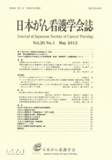Japanese
English
- 販売していません
- Abstract 文献概要
- 参考文献 Reference
- サイト内被引用 Cited by
要旨
本研究の目的は,喉頭摘出者の術前から退院後1年間の他者とのコミュニケーションを通したコミュニケーション方法の再構築過程を明らかにし,その過程を支援する看護実践への示唆を得ることである.対象は喉頭全摘術を受ける頭頸部がん患者12名で,術前から退院後1年間にわたって参加観察および半構成的面接を行い修正版グラウンデッド・セオリー・アプローチを用いて分析した.
その結果,喉頭摘出者の他者とのコミュニケーションを通したコミュニケーション方法の再構築過程は,『伝わらないことによって膨張化した欲求不満状態からの脱却化』を図る過程であった.この過程は,失声の予告が引き起こした〈声を失うことのイメージ化〉および【命と声の引き換え】の覚悟を持ち【喉頭発声機能喪失下での伝達の再適正化・再円滑化・効率化】を目指すことから始まり,術後の【相手を見て・合わせて・ひたすら伝える】ことを起点に生じた3つのサイクル,すなわちさらなる【喉頭発声機能喪失下での伝達の再適正化・再円滑化・効率化】を図るサイクル,【伝わらない伝えられない・話せない話さないことへの欲求不満の膨張化】を引き起こすサイクル,〈人とのコミュニケーションを楽しむ〉および【極限までに縮小化されたコミュニケーションからのわずかな拡充化】を図るサイクル,および【伝わらない伝えられない・話せない話さないことへの欲求不満の膨張化】を起点に【命と声の引き換え】の覚悟を想起するサイクル,の計4つのサイクルが相互に連動して循環するなかで患者は〈欲を出す〉ようになり,その欲を原動力としてさらなる【極限までに縮小化されたコミュニケーションからのわずかな拡充化】を図り,それがまた4つのサイクルを動かしていくという循環型の過程であった.患者自身が自然に〈欲を出す〉まで待ち続けその時の到来を見逃さないこと,〈欲を出す〉までに患者および周囲の人が体験する苦悩を緩和すること,という看護実践の必要性が示唆された.
Abstract
The purpose of this study was twofold: identify the process laryngectomized patients used in reestablishing their communication style from the perioperative period to one year after discharge, and obtain insights into nursing practice in support of this process. The study included 12 patients with head and neck cancer who were scheduled to undergo total laryngectomy. Data were collected using participant observation and semi-structured interviews from the preoperative period up to one year after discharge, and analyzed through a qualitative inductive approach.
The process used by laryngectomized patients in reestablishing communication style represented that of "a departure from increased frustration because they could not make themselves understood." This process began with "building an image of loss of voice" secondary to advance notice of loss of voice and "reoptimization of communication, reestablishment of a smooth form of communication and promotion of the efficiency of communication in the absence of laryngeal phonatory function," and being prepared for "loss of voice in exchange for life." In the postoperative period, "a desire was aroused" in patients over a course of four cycles, which worked together and were repeated, thereby further driving a "slight expansion of minimized communication." Three cycles originating from "looking at someone with whom to communicate, coordinating with the person and concentrating on communication"(1)a cycle of further "reoptimization of communication: reestablishment of a smooth form of communication and promotion of the efficiency of communication in the absence of laryngeal phonatory function,"(2)a cycle of inducing "increased frustration not being able to make themselves understood and not speaking/not being able to speak" and(3)a cycle of "enjoying communicating with others" and "slight expansion of minimized communication")and(4)one cycle of recalling the preparedness for "loss of voice in exchange for life" originating from the cycle of inducing "increased frustration at patients not being able to make themselves understood and not speaking/ not being able to speak." As this process was iterative and cyclical, it led to the recurrence of these four cycles. The study suggested the need for nursing practice in waiting until "a desire is aroused" spontaneously in patients, not missing the arrival of that time, and in relieving the suffering of patients and people around them until "a desire is aroused."
Copyright © 2012, Japanese Society of Cancer Nursing All rights reserved.


